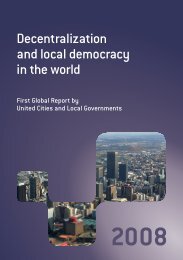Making Cities Resilient Report 2012
Making Cities Resilient Report 2012
Making Cities Resilient Report 2012
You also want an ePaper? Increase the reach of your titles
YUMPU automatically turns print PDFs into web optimized ePapers that Google loves.
Introduction<br />
Background and rationale<br />
Today, more than half the global population resides in urban areas. By 2025, roughly two-thirds of the<br />
world’s inhabitants and the vast majority of wealth will be concentrated in urban centres. Many of the<br />
world’s mega-cities, characterized as those with populations exceeding 10 million, are already situated<br />
in locations already prone to major earthquakes and severe droughts, and along flood-prone coastlines,<br />
where the impacts of more extreme climatic events and sea level rise pose a greater risk to disasters.<br />
Urbanisation happening in relatively smaller cities is also a concern—particularly in regions where<br />
existing infrastructure and institutions are ill equipped to cope with disasters. The vulnerability of this new<br />
generation of urbanites will become a defining theme of disaster risk in the coming decades. Against this<br />
backdrop, the report observes two diverging trends relevant to strengthening urban resilience.<br />
The first is one in which competent, sufficiently resourced city and municipal governments work with<br />
citizens, businesses and other stakeholders to reduce disaster risk, both through specific risk reduction<br />
policies and investments, and by improving infrastructure and the provision of services. There is much<br />
innovation to celebrate here. These policies and measures also help build resilience to climate change.<br />
There are also notable successes in cities located in low- and middle-income nations, demonstrating that<br />
resilience is not exclusive to high-income nations.<br />
The second trend points to many cases in which national and local governments’ attention to disaster risk<br />
reduction activities, or to the institutions, infrastructure and services that help build resilience, is failing to<br />
keep pace with the rapid rate of urbanization they are witnessing. There are also many cities and smaller<br />
urban centres where even the best-oriented disaster risk reduction policies have limited impact due to<br />
large deficits in critical social infrastructure and local investment capacity.<br />
Consequently, one of the key issues for building urban resilience is how to support and learn from the<br />
innovators and leverage significant changes in city-level resilience, even where there are limited resources.<br />
It is in this context that the United Nations Office for Disaster Risk Reduction (UNISDR) commissioned the<br />
International Institute for Environment and Development (IIED) to report on the disaster risk reduction<br />
activities being undertaken at city and municipal levels in selected urban areas.<br />
The cities reviewed for this report all are signatories to the global campaign on <strong>Making</strong> <strong>Cities</strong> <strong>Resilient</strong>-<br />
My City is Getting Ready! UNISDR founded the Campaign in May 2010 in conjunction with several partner<br />
organizations, including the United Nations Human Settlements Programme (UN-Habitat), United Cites<br />
and Local Governments, (UCLG), ICLEI-Local Governments for Sustainability (ICLEI), CityNet, the European<br />
Commission Community Humanitarian Office (ECHO), the World Bank Global Facility for Disaster Reduction<br />
and Recovery (GFDRR), academic institutions and civil society groups. The launch of the Campaign marked<br />
a recognition of the importance of supporting local-level leadership against the backdrop of rapid global<br />
urbanisation and the role of local governments as both first responders to crises and emergencies and<br />
those responsible for local development plans, building regulations and basic services.<br />
As of August <strong>2012</strong>, 1,050 cities and local governments had signed on to the Campaign, and in doing so, have<br />
pledged to take steps to improve their cities’ resilience to disasters. These include 29 role model cities that<br />
are recognised by the Campaign as exemplars in disaster risk management and reduction. These cities<br />
share their knowledge of best practices on a wide range of challenges, including flood management, early<br />
warning, earthquake reconstruction and legislation.<br />
From San Francisco, Philippines, to San Francisco, California, the Campaign’s constituency ranges from<br />
small municipalities in developing nations to some of the world’s most populous and economically vibrant<br />
capital cities. And while there are significant differences in the ability of local governments to cope with<br />
8 | <strong>Making</strong> <strong>Cities</strong> <strong>Resilient</strong> <strong>Report</strong> <strong>2012</strong>

















